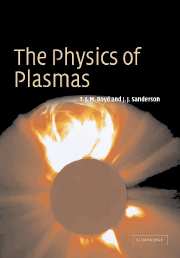Book contents
- Frontmatter
- Contents
- Preface
- 1 Introduction
- 2 Particle orbit theory
- 3 Macroscopic equations
- 4 Ideal magnetohydrodynamics
- 5 Resistive magnetohydrodynamics
- 6 Waves in unbounded homogeneous plasmas
- 7 Collisionless kinetic theory
- 8 Collisional kinetic theory
- 9 Plasma radiation
- 10 Non-linear plasma physics
- 11 Aspects of inhomogeneous plasmas
- 12 The classical theory of plasmas
- Appendix 1 Numerical values of physical constants and plasma parameters
- Appendix 2 List of symbols
- References
- Index
7 - Collisionless kinetic theory
Published online by Cambridge University Press: 06 July 2010
- Frontmatter
- Contents
- Preface
- 1 Introduction
- 2 Particle orbit theory
- 3 Macroscopic equations
- 4 Ideal magnetohydrodynamics
- 5 Resistive magnetohydrodynamics
- 6 Waves in unbounded homogeneous plasmas
- 7 Collisionless kinetic theory
- 8 Collisional kinetic theory
- 9 Plasma radiation
- 10 Non-linear plasma physics
- 11 Aspects of inhomogeneous plasmas
- 12 The classical theory of plasmas
- Appendix 1 Numerical values of physical constants and plasma parameters
- Appendix 2 List of symbols
- References
- Index
Summary
Introduction
Much of plasma physics can be adequately described by fluid equations, namely, the MHD or wave equations. However, these are derivative descriptions in which some information about the plasma has been suppressed. In situations where that information matters it is necessary to go to a deeper level of physical description.
The information that gets lost in a fluid model is that relating to the distribution of velocities of the particles within a fluid element, since the fluid variables are functions of position and time but not of velocity. Any physical properties of the plasma that depend on this microscopic detail can be discovered only by a description in six-dimensional (r, v) space. Thus, instead of starting with the density of particles, n(r, t), at position r and time t, we begin with the so-called distribution function, f (r, v, t), which is the density of particles in (r, v) space at time t. The evolution of the distribution function is described by kinetic theory.
With the additional information on particle velocities within a volume element introduced by a phase space description we now have microscopic detail that we did not have before. For that reason, kinetic and fluid theories are identified as microscopic and macroscopic, respectively.
Information
- Type
- Chapter
- Information
- The Physics of Plasmas , pp. 252 - 295Publisher: Cambridge University PressPrint publication year: 2003
